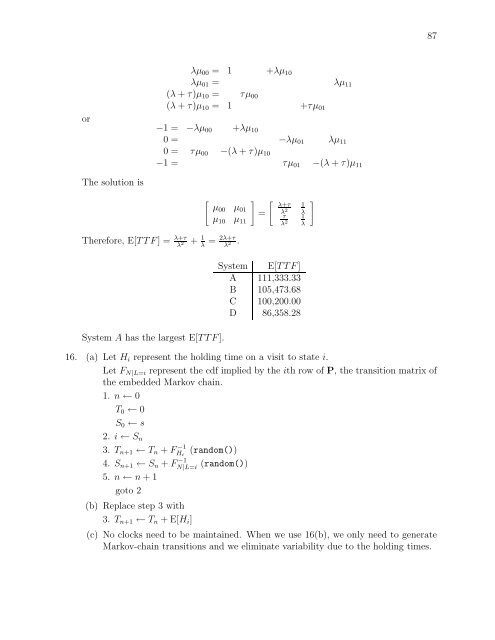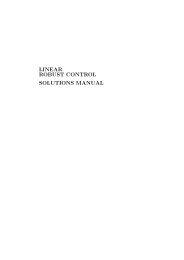SOLUTIONS MANUAL for Stochastic Modeling: Analysis and ...
SOLUTIONS MANUAL for Stochastic Modeling: Analysis and ...
SOLUTIONS MANUAL for Stochastic Modeling: Analysis and ...
Create successful ePaper yourself
Turn your PDF publications into a flip-book with our unique Google optimized e-Paper software.
87<br />
or<br />
λµ 00 = 1 +λµ 10<br />
λµ 01 = λµ 11<br />
(λ + τ)µ 10 = τµ 00<br />
(λ + τ)µ 10 = 1 +τµ 01<br />
−1 = −λµ 00 +λµ 10<br />
0= −λµ 01 λµ 11<br />
0= τµ 00 −(λ + τ)µ 10<br />
−1 = τµ 01 −(λ + τ)µ 11<br />
The solution is<br />
[ ]<br />
µ00 µ 01<br />
=<br />
µ 10 µ 11<br />
[ λ+τ<br />
λ<br />
τ<br />
2 λ<br />
1<br />
1<br />
λ 2 λ<br />
]<br />
There<strong>for</strong>e, E[TTF]= λ+τ<br />
λ 2<br />
+ 1 λ = 2λ+τ<br />
λ 2 .<br />
System A has the largest E[TTF].<br />
System E[TTF]<br />
A 111,333.33<br />
B 105,473.68<br />
C 100,200.00<br />
D 86,358.28<br />
16. (a) Let H i represent the holding time on a visit to state i.<br />
Let F N|L=i represent the cdf implied by the ith row of P, the transition matrix of<br />
the embedded Markov chain.<br />
1. n ← 0<br />
T 0 ← 0<br />
S 0 ← s<br />
2. i ← S n<br />
3. T n+1 ← T n + FH −1<br />
i<br />
(r<strong>and</strong>om())<br />
4. S n+1 ← S n + F −1<br />
N|L=i (r<strong>and</strong>om())<br />
5. n ← n +1<br />
goto 2<br />
(b) Replace step 3 with<br />
3. T n+1 ← T n +E[H i ]<br />
(c) No clocks need to be maintained. When we use 16(b), we only need to generate<br />
Markov-chain transitions <strong>and</strong> we eliminate variability due to the holding times.















